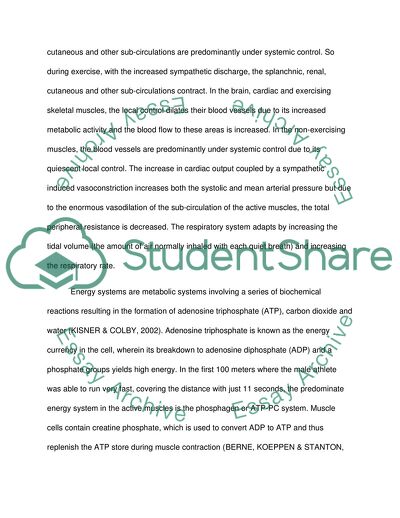
- Home
- Free Samples
- Premium Essays
- Editing Services
- Extra Tools
- Essay Writing Help
- About Us
- Studentshare
- Subjects
- Miscellaneous
- Detailed Explanation
Detailed Explanation - Essay Example

- Subject: Miscellaneous
- Type: Essay
- Level: Undergraduate
- Pages: 4 (1000 words)
- Downloads: 0
- Author: elemke
Extract of sample "Detailed Explanation"
in an increase in stroke volume, which is the amount of blood ejected by heart in one contraction and an increase in cardiac output, which is the amount of blood pumped by the heart in one minute. Another physiologic change in the cardiovascular system is the redistribution of cardiac output to the different organs. Under resting condition, the skeletal muscle only receives 21% of the cardiac output but this increases dramatically during exercise. Blood flow, according to Ohm’s Law, directly proportional to Mean Arterial Pressure and inversely proportional to Resistance.
Resistance of the different organs is regulated by systemic or local control. Systemic or extrinsic control is exemplified by the sympathetic nervous system and local control is based on an organ’s metabolic needs, usually mediated by a chemical released by the said organ. The brain, heart and skeletal muscle sub-circulations are predominantly under local control whereas the splanchnic, renal, cutaneous and other sub-circulations are predominantly under systemic control. So during exercise, with the increased sympathetic discharge, the splanchnic, renal, cutaneous and other sub-circulations contract.
In the brain, cardiac and exercising skeletal muscles, the local control dilates their blood vessels due to its increased metabolic activity and the blood flow to these areas is increased. In the non-exercising muscles, the blood vessels are predominantly under systemic control due to its quiescent local control. The increase in cardiac output coupled by a sympathetic induced vasoconstriction increases both the systolic and mean arterial pressure but due to the enormous vasodilation of the sub-circulation of the active muscles, the total peripheral resistance is decreased.
The respiratory system adapts by increasing the tidal volume (the amount of air normally inhaled with each quiet breath) and increasing the respiratory rate. Energy systems are metabolic systems involving a series of biochemical
...Download file to see next pages Read MoreCHECK THESE SAMPLES OF Detailed Explanation
Oscilloscope from the Position of a Marketing
The Orientation Problem
U05a1 Project Annotated Outline and Annotated Bibliography
Reducing the Threat Levels for Accounting Information Systems
Concept of Operations
Cultural Differences
Week 3 Reflection
Chinas Milk Industry

- TERMS & CONDITIONS
- PRIVACY POLICY
- COOKIES POLICY